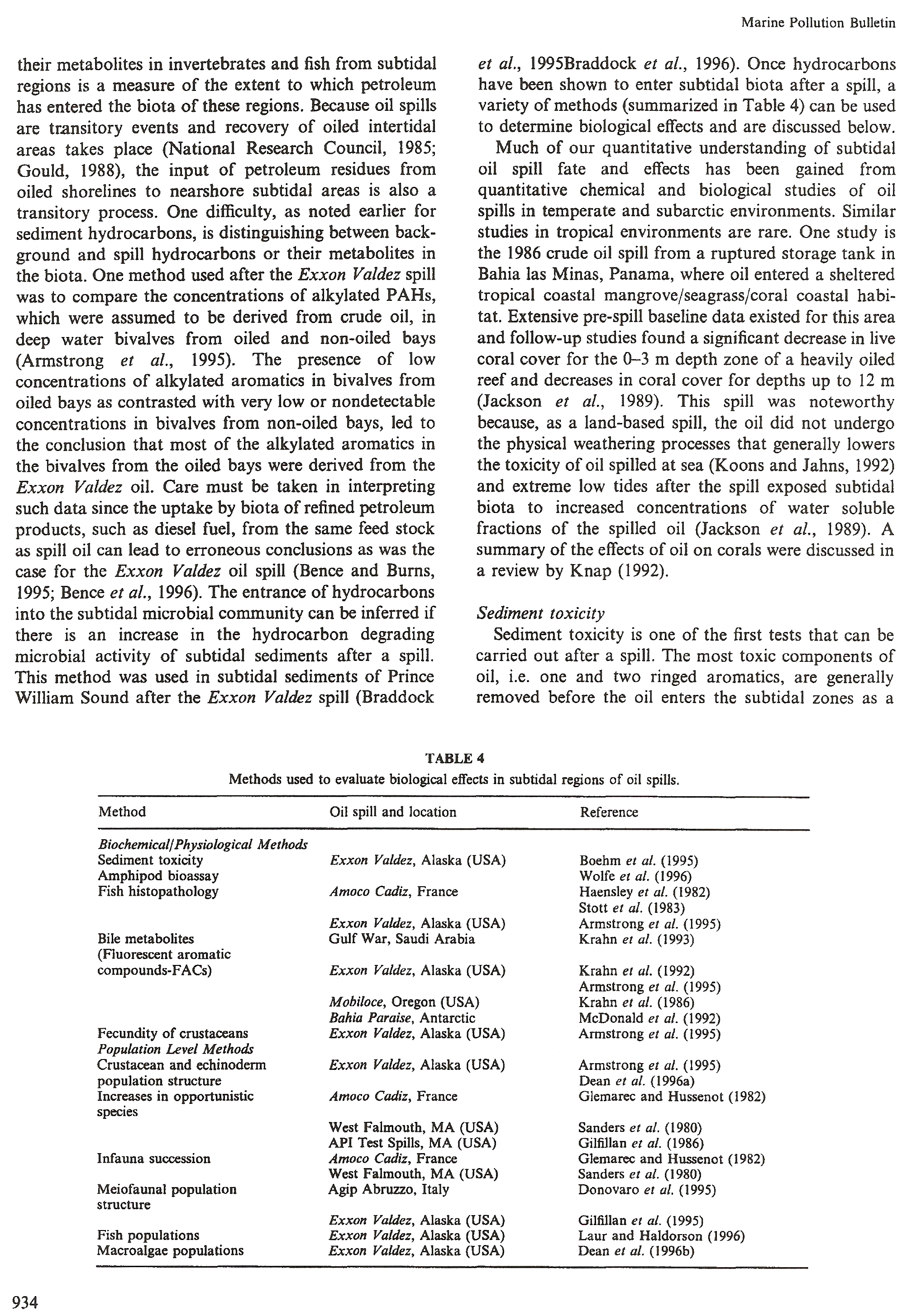11465 scan0028 (3)

Marinę Pollution Bulletin
their metabolites in invertebrates and fish from subtidal regions łs a measure of the extent to which petroleum has entered the biota of these regions. Because oil spills are transitory events and recovery of oiled intertidal areas takes place (National Research Coimcil, 1985; Gould, 1988), the input of petroleum residues from oiled shorelines to nearshore subtidal areas is also a transitory process. One difficulty, as noted earlier for sediment hydrocarbons, is distinguishing between back-ground and spili hydrocarbons or their metabolites in the biota. One method used after the Exxon Yaldez spili was to compare the concentrations of alkylated PAHs, which were assumed to be derived from crude oil, in deep water bivalves from oiled and non-oiled bays (Armstrong et al., 1995). The presence of Iow concentrations of alkylated aromatics in bivalves from oiled bays as contrasted with very Iow or nondetectable concentrations in bivalves from non-oiled bays, led to the conclusion that most of the alkylated aromatics in the bivalves from the oiled bays were derived from the Exxon Yaldez oil. Care must be taken in interpreting such data sińce the uptake by biota of refined petroleum products, such as diesel fuel, from the same feed stock as spili oil can lead to erroneous conclusions as was the case for the Exxon Yaldez oil spili (Bence and Burns, 1995; Bence et al., 1996). The entrance of hydrocarbons into the subtidal microbial community can be inferred if there is an increase in the hydrocarbon degrading microbial activity of subtidal sediments after a spili. This method was used in subtidal sediments of Prince William Sound after the Exxon Yaldez spili (Braddock et al., 1995Braddock et al., 1996). Once hydrocarbons have been shown to enter subtidal biota after a spili, a variety of methods (summarized in Table 4) can be used to determine biological elfects and are discussed below.
Much of our quantitative understanding of subtidal oil spili fate and effects has been gained from quantitative Chemical and biological studies of oil spills in temperate and subarctic environments. Similar studies in tropical environments are rare. One study is the 1986 crude oil spili from a ruptured storage tank in Bahia las Minas, Panama, where oil entered a sheltered tropical Coastal mangrove/seagrass/coral Coastal habitat. Extensive pre-spill baseline data existed for this area and follow-up studies found a significant decrease in live coral cover for the 0-3 m depth zonę of a heavily oiled reef and decreases in coral cover for depths up to 12 m (Jackson et al., 1989). This spili was noteworthy because, as a land-based spili, the oil did not undergo the physical weathering processes that generally lowers the toxicity of oil spilled at sea (Koons and Jahns, 1992) and extreme Iow tides after the spili exposed subtidal biota to increased concentrations of water soluble fractions of the spilled oil (Jackson et al., 1989). A summary of the effects of oil on corals were discussed in a review by Knap (1992).
Sediment toxicity
Sediment toxicity is one of the first tests that can be carried out after a spili. The most toxic components of oil, i.e. one and two ringed aromatics, are generally removed before the oil enters the subtidal zones as a
TABLE4
Methods used to evaluate biological effects in subtidal regions of oil spills.
Method Oil spili and location Reference
Biochemical/Physiological Methods Sediment toxicity Amphipod bioassay Fish histopathology
Bile metabolites (Fluorescent aromatic compounds-FACs)
Fecundity of crustaceans Population Level Methods Crustacean and echinoderm population structure Increases in opportunistic species
Infauna succession
Meiofaunal population structure
Fish populations Macroalgae populations
Exxon Paldez, Alaska (USA)
Amoco Cadiz, France
Exxon Valdez, Alaska (USA) Gulf War, Saudi Arabia
Exxon Yaldez, Alaska (USA)
Mobiloce, Oregon (USA) Bahia Paraise, Antarctic Exxon Yaldez, Alaska (USA)
Exxon Yaldez, Alaska (USA)
Amoco Cadiz, France
West Falmouth, MA (USA) API Test Spills, MA (USA) Amoco Cadiz, France West Falmouth, MA (USA) Agip Abruzzo, Italy
Exxon Yaldez, Alaska (USA) Exxon Yaldez, Alaska (USA) Exxon Yaldez, Alaska (USA)
Boehm et al. (1995)
Wolfe et al. (1996)
Haensley et al. (1982)
Stott et al. (1983)
Armstrong et al. (1995)
Krahn et al. (1993)
Krahn et al. (1992)
Armstrong et al. (1995)
Krahn et al. (1986)
McDonald et al. (1992) Armstrong et at. (1995)
Armstrong et al. (1995)
Dean et al. (1996a)
Glemarec and Hussenot (1982)
Sanders et al. (1980)
Gilfillan et al. (1986)
Glemarec and Hussenot (1982) Sanders et al. (1980)
Donovaro et al. (1995)
Gilfillan et al. (1995)
Laur and Haldorson (1996) Dean et al. (I996b)
934
Wyszukiwarka
Podobne podstrony:
55750 scan0026 (4) Marinę Pollution Bulletin TABLE 3 Hydrocarbons concentrations in particles collec
15846 scan0024 (4) Marinę Pollution Bulletin TABLE2 Concentrations of total petroleum hydrocarbons (
60761 scan0034 (2) Marinę Pollution Bulletin Page, D. S., Foster, J. C., Pickett, P. M. and Gilfilla
ST7 - 1/0 ports - alternate function in DDR and OR registers: bit X corresponding to pin X of the po
scan0022 (5) Pergamon Pil: S0025-326X(97)00078-7 Marinę Pollution Bulletin, Vol. 34, No. II, pp. 928
43959 scan0032 (4) Marinę Pollution BuUetin histopathology of fish, increases in opportunistic speci
18805 scan0030 (2) Marinę Pollulion Bulletin Petroleum hydrocarbons by fish. After metabolism by pha
3 Ethnoccntrism in German and -Polish Textbooks 55 ^Europę is to present the facts in their rea
00150 D9acbde9d435381a2e9b8d77b152fd5 151 Optimization and Sensitmty Analysis account for over 90%
Paradiddle Power 6 Part 5: Jazz Fills With Triple Paradiddles In Triplets Here again, notę that only
BSc IN ENVIRONMENTALPROTECTION AND MANAGEMENT Degree to be obtained Bathelor of Science Duration
więcej podobnych podstron